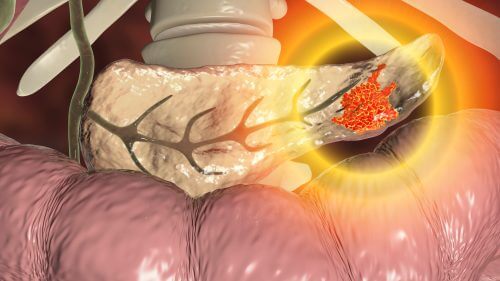A clinical trial is planned for the coming months

A group of Israeli researchers in California revealed in an article recently published (November 18, 2019) in the journal Nature Cell Biology a new and unexpected weakness of pancreatic cancer, which makes it possible through a combination of two drugs to fight this deadly and resistant cancer to existing treatments and perhaps even defeat it earlier than expected.
A group led by Prof. Zev Ronai and gastrologist Dr. Erez Hasenis from the Rambam Medical Center in Haifa, who is currently undergoing research training in the field of the pancreas at the Saberford-Burnham-Pervis Institute for Medical Discovery (SBPMDI), used the drug L-asparaginase to lower the level of the amino acid asparagine in the pancreas of mice with pancreatic cancer. However, it turns out that the tumors coped with the decrease in asparagine level by regulating an enzyme that synthesizes asparagine (ASNS), which allows them to synthesize asparagine themselves, making them resistant to the treatments.
At this point, the researchers followed the changes in those adapted cells to identify the gene controlling ASNS expression, which led to more efficient expression of ASNS. The researchers combined the drug L-asparaginase with a MAPK pathway inhibitor. Now the starved cells were unable to cope with the loss of asparagine, which ended in intensive death of cancer cells and significant shrinkage of the pancreatic tumors.
The mathematical and computational basis for this work was provided by Prof. Eitan Rupin, a former researcher at Tel Aviv University, and currently the chief data scientist at the National Cancer Institute in Bethesda, Maryland.
According to Dr. Hasenis, the findings of this study have already attracted the attention of the scientific and medical community, and a preliminary clinical study with the combination of the drugs among pancreatic cancer patients is planned for the near future, which instills optimism among patients, families and doctors alike.
In an interview with the Hidan website, Dr. Hasenis explains that the initial scientific question was how it could be that certain tumors as well as melanoma do not respond to L-asparaginase chemotherapy treatment (a drug based on an enzyme that breaks down the amino acid asparagine, which has failed in quite a few clinical trials), on Although their level of the asparagine synthesizing enzyme ASNS - asparagine synthetase is low. Asparagine is a critical amino acid, without which protein synthesis cannot be carried out sufficiently well. That is, if they are unable to synthesize much asparagine, how do they survive the asparagine loss caused by the drug?
"The initial line of thought was that the cells sense the decrease in asparagine, and increase the expression of the ASNS gene in response, but we had no idea how they do it. To get a direction for the answer, we asked Eitan Rupin's team in Maryland to find us the synthetic lethal partners of ASNS, that is, to locate the genes, that in cases where ASNS was low in the tumors, then a minority in the expression of these genes led to a long survival of the patients, that is, to a reduced violence of the tumor . In other words, when a tumor has too little ASNS, what other genes does it become dependent on to continue to thrive?”
"His team worked for several weeks on analyzing the big data and managed to locate seven such genes. Surprisingly, they were all on one signaling pathway - the MAPK pathway - mitogen activated protein kinases."
"After the calculations, it took another year to understand the mechanism. It turned out that when there is a decrease in asparagine, there is an inefficient translation of proteins. The cancer cell senses this, and begins to translate a very specific group of proteins from new areas in their RNA, areas that bind with higher affinity to ribosomes, so their translation becomes more efficient than other proteins and their relative share in the cell's proteins increases. One of these proteins is called ATF4, which is now relatively high, and it is the protein that increases the transcription of ASNS. Therefore, the cancer cell begins to synthesize asparagine and copes with the chemotherapy."
"At this stage we moved to mice - both in a model of melanoma and of pancreatic cancer, the tumors were injected, and mice were divided into four groups: a control group, a group that received treatment with L-asparaginase, a group that received treatment with a new molecule that inhibits the MAPK pathway, and a fourth group which combines the two drugs. All the treatments helped even a little, but the combination of the drugs significantly reduced the size of the tumor. Indeed, in tumors treated with L-asparaginase alone there was an increase in ATF4 and therefore also in ASNS, while in tumors treated with both drugs this increase was prevented and the tumor basically succumbed."
"The results were presented to oncologists who lead clinical studies in the US. Melanoma already has quite a few effective lines of treatment and they are giving up on the new drug at the moment. Pancreatic cancer still has no solution, so we are starting to get funding, draft IRBs, and start a clinical trial in the first half of 2020 at OHSU Medical Center in Portland, Oregon." Dr. Hasenis concludes.
https://www.nature.com/articles/s41556-019-0415-1

2 תגובות
Someone answer Steve!
I have the impression that in many cases (if not in the absolute majority) medicines are discovered in surprising and unexpected ways, when chemical substances act in an unexpected way on a particular disease. If this is indeed the case, I ask myself when we will be able to translate the diseases and the chemical substances into computer programs in order to run huge amounts of simulations in real time and thus allow computational power to find the cures by trial and error.. Are quantum computers necessary to run such simulations? Are they even physically possible?